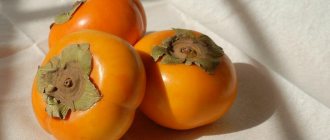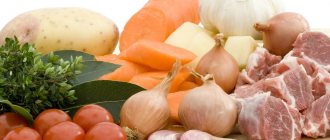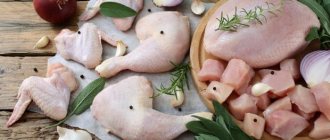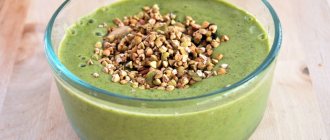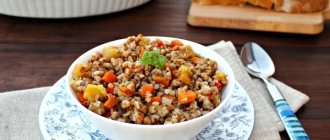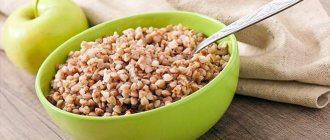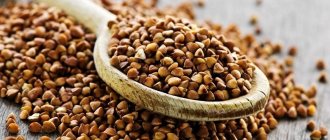Photos of foods containing significant amounts of iodine
From this article you can find out how much such an important trace element as iodine is contained in food; The table posted here will show what you need to eat to saturate your body with it. In addition, information is provided on which foods are completely devoid of iodine, and this data is also presented in the form of a table.
The total amount of iodine in the human body is small - only 25 mg. However, a lot depends on this microelement, because it is necessary for the normal functioning of the thyroid gland, which plays the first violin in regulating metabolism. Iodine deficiency can cause serious disruptions in the functioning of every system of the human body.
If a child encounters a deficiency of an element, he may develop significant problems with mental and physical development. To prevent this from happening, you should eat foods rich in iodine; a table for the thyroid gland giving information on the content of this element in various types of food is given below.
Interesting! During the day, the human body consumes about 3 mcg of iodine for every kilogram of its weight. Pregnancy, hypothermia and increased growth cause an increase in the consumption of this microelement. Iodine is removed from the body through the salivary glands and kidneys.
Daily requirement
Article on the topic The health gland: what threatens problems with the thyroid gland and how to avoid them It depends on age: for infants the daily requirement is 50 mcg, for children aged 2-6 years - 90 mcg, 7-12 years - 120 mcg, for an adult - 150 mcg, for pregnant and lactating women the need is slightly higher - 200 mcg.
And for a person suffering from thyroid diseases, the daily need for iodine can increase several times.
A tenth of the need for iodine is provided by air and water, and the rest comes into the body with food. This is why it is important to eat a healthy and balanced diet and consume iodine-containing foods.
The most iodine is found in products of marine origin: seaweed, caviar, cod, haddock and tuna meat, shrimp and squid. There is iodine in vegetables and fruits, for example, persimmons, black currants, cucumbers, potatoes and garlic.
What foods will help us avoid iodine deficiency and strengthen the thyroid gland?
Too little or too much
An excess of iodine has a noticeable effect on health and appearance. The skin becomes dry, hair and nails become brittle, weight increases, although nutrition remains the same, cellulite appears, arrhythmia and surges in blood pressure are a concern. In addition, performance decreases, and blues and apathy become faithful companions. By the way, this is exactly what the classic onset of depression looks like.
With a lack of iodine, an equally sad picture is observed - frequent constipation and swelling, and an unhealthy hoarseness may appear in the voice. The psycho-emotional state is not stable - irritation accumulates, it is difficult to concentrate on something and remember important information.
If you notice some of the above symptoms, check with your doctor - you may not have enough iodine and should pay attention to products with iodine to restore the functioning of the thyroid gland. By the way, there is also a popular effective method to make an initial diagnosis. Apply an iodine grid to your skin - if it disappears within a day, it means you have a clear iodine deficiency.
Red caviar
One of the most valuable products - because the protein of red caviar is absorbed much easier and faster than the proteins contained in dairy and meat products. In addition, red caviar contains a large amount of iodine in an easily digestible form. Other vitamins and microelements help in the absorption of iodine: phosphorus, potassium, iron, vitamins A, D, E.
Vol-au-vents with red caviar
1 package of puff pastry without yeast 1 jar of red caviar 2 tbsp. butter 2 tbsp. soft cheese 1 egg white Herbs for decoration
Article on the topic
We choose red caviar and smoked fish. Useful tips Step 1. Thaw the dough and roll it out on a table sprinkled with flour. Step 2. Use a glass to cut the dough into circles. Using a smaller glass or shot glass, cut half of the circles into rings. Step 3. Grease a baking sheet with oil. Place the mugs on it, brush with whipped egg white, place rings on top, brush with egg white again. The rings will stick, rise a little - and you will get walls. Step 4. Place in the oven at 200 degrees and bake until golden brown for about 15 minutes. Step 5. Remove and cool slightly. Step 6. Place a piece of butter and half a teaspoon of soft cheese into the vol-au-vents. Place red caviar on top and garnish with herbs. Best served warm. But cold vol-au-vents are also very tasty.
And what else?
Let's add to the list of foods high in iodine so that the menu does not seem too meager and boring. For breakfast, you can cook buckwheat or millet porridge with milk, in which, according to scientists, the concentration of iodine increased at the end of the last century due to changes in the composition of cow feed. A glass of milk contains almost 40% of the daily dose of iodine. Diversify your diet with cheeses, walnuts, eggs, mushrooms, yogurt and butter! In one jar of natural yogurt you will find about 60% of the daily requirement of iodine. Interestingly, in the old days in China there was a tradition of giving newlyweds butter enriched with iodine for their wedding so that the pregnancy would proceed normally and children conceived on the honeymoon would be born healthy.
Previously, doctors advised salting food with iodized salt, but now opinions about this product differ. On the one hand, 5 g of salt contains 100–200 mcg of iodine, which solves the problem of lack of it in the diet. But, on the other hand, iodine quickly evaporates from salt during the cooking process, so in some ways its use makes no sense. However, if you keep the salt away from light and eat the food immediately after cooking, the health benefits will undoubtedly be there!
The proper amount of iodine in food will have a beneficial effect on overall well-being, help restore mental balance and increase vitality.
Watch what you eat, and life will shine with new colors!
Sea kale
Just 100 grams of seaweed per day - and the daily requirement for iodine is met. It is not surprising that cabbage has a characteristic iodine smell - there is a lot of iodine here, and it is also easily absorbed. In addition to iodine, you can get vitamins A, E, C, group B, as well as iron and magnesium from cabbage.
Millet and seaweed casserole
200 g seaweed 1 cup millet 2 onions 4 tbsp. butter 2 eggs 3 tbsp. sour cream 3 tbsp. bread crumbs 100 g grated cheese
Step 1. Rinse the millet thoroughly and cook a viscous porridge (for 1 cup of cereal - 3 cups of water). Step 2. Fry the onion in vegetable oil and add to the porridge. Cool until warm. Step 3. Add seaweed and eggs to the porridge. Place in a mold greased with butter and sprinkled with breadcrumbs. Step 4. Mix cheese with some crackers and sour cream. Place on top of the casserole and smooth out. Step 5. Bake in the oven for 15 minutes at 200 C.
Products containing iodine
This important microelement enters the human body mainly with plant foods (64%), followed by animal foods (32%) and third by water (4%).
Dried seaweed is the richest food in iodine.
So, where is iodine contained, table:
| The product's name | Peculiarities | Iodine content (µg/100 g) | Percent Daily Value for an Adult |
| Potatoes (baked) | Be sure to bake with the skin on, since, for example, puree contains much less iodine | 60 | 40 |
| Cranberry (pie) | It also contains quite a lot of vitamin C. | 400 | 270 |
| Prunes | A serving of this dried fruit also contains fiber, vitamins K and A, and boron ions. | 13 | 9 |
| Cod | This fish is very tasty and low in fat. | 116 | 77 |
| Lobster | In terms of taste, it is considered the king among seafood | 100 | 66 |
| Shrimps | Storehouse of calcium and protein | 35 | 23 |
| Tuna (canned) | Also rich in proteins, iron salts and vitamin D | 20 | 13 |
| Dried seaweed | Sold in 7 gram packs | 64285 | 41785 |
| Turkey breast (baked) | Contains B vitamins, potassium, phosphorus | 35 | 23 |
| Milk | Supplying the body with vitamin D and calcium | 28 | 18 |
| Egg (boiled) | Contains zinc, calcium, antioxidants, vitamins D and A | 24 | 15 |
| Iodized salt | You shouldn’t over-salt your dishes in pursuit of iodine; it will do more harm than good. | 7 700 | 5 331 |
| Himalayan salt (halite) | It is pink in color and rich in many other microelements. It is not recommended to consume more than half a gram of the substance per day | 50 000 | 30 000 |
| Strawberry | Tasty and rich in microelements | 13 | 9 |
| Sea beans | The product also contains large quantities of amino acids, copper, calcium, potassium and folic acid. | 32 | 22 |
| White bread | It should be consumed in moderation as it contains many calories. | 45 | 30 |
Based on this information, you can choose a menu for yourself from available products that contain a sufficient amount of iodine.
Persimmon
There is quite a lot of iodine in persimmon, although not as much as in seaweed. But many more people like persimmon. In addition to beneficial iodine, it contains magnesium, sodium, iron (in terms of their content it surpasses even apples, the well-known healthiest fruit), as well as vitamins A, C and P.
Persimmon mousse
3 persimmons 1 glass of sugar ½ packet of gelatin 2 tbsp. lemon juice 1.5 cups water
Article on the topic
Salads, side dishes, casseroles and pies. What to cook from persimmons Step 1. Wash the persimmons, cut into quarters, remove the seeds. Step 2. Fill with water, add lemon juice. Leave for half an hour. Step 3. Boil in the same water for 15 minutes. While it is boiling, soak the gelatin in ½ cup of cold water. Step 4. Rub the boiled persimmon through a sieve. Pour the strained broth into it, add sugar and add gelatin. Mix. Step 5. Cool the finished mass to a temperature warmer than room temperature, then beat until thick foam. Step 6. Pour into molds and place in the refrigerator to set.
What is the best way to absorb iodine?
To ensure that the body receives the maximum amount of iodine from food or supplements, it is recommended to additionally take the following cofactors:
- Selenium. Helps convert the T4 hormone to T3. Without it, iodine ions begin to accumulate in the thyroid gland - free radicals, leading to cell poisoning.
- Iron. Supports the production of the enzyme thyroid peroxidase and prevents disruption of thyroxine synthesis.
It is also worth noting that heat treatment reduces the content of iodine and other beneficial substances in food. Therefore, whenever possible, it is better to consume fresh foods.
Read the blog: What are the benefits of proanthocyanidins for human health?
Buckwheat
Perhaps the most useful and favorite cereal in Russia. Buckwheat also contains iodine; in terms of its content, it is a champion in the world of cereals. In addition, buckwheat contains many useful vitamins and microelements that will help absorb iodine.
Buckwheat in field conditions
1 cup buckwheat 2 cups water 1 can of stewed meat 1 bell pepper 2 tomatoes 2 cloves of garlic
Step 1. Heat the buckwheat in a dry frying pan with a thick bottom, pour boiling water over it and cook. Step 2. Fry the onion in a frying pan, then add finely diced pepper to it, fry everything together, then add tomatoes, cut into small pieces, and add salt. Cover with a lid and simmer. Step 3. Open the stew, cut it with a knife directly in the jar and place it with the vegetables. Fry everything, stirring. Step 4. Add cooked buckwheat to fry. Add salt and pepper to taste. Serve with green salad.
Signs of shortage
If a person does not receive enough iodine during intrauterine development, then hypothyroidism develops, which causes profound disturbances in the functioning of higher nervous activity.
In adults, iodine deficiency causes:
- decreased mental abilities;
- lethargy;
- lethargy;
- irritability;
- melancholy, forgetfulness;
- swelling of the face, torso, legs, or arms;
- constipation;
- deaf-mute;
- stillbirth, fetal anomalies, increased perinatal mortality;
- paralysis;
- decrease in body strength, frequency of contraction of the heart muscle;
- the occurrence of diastolic hypertension;
- inhibition of the energy supply process, under-oxidation of metabolic products;
- slagging of the body.
The process of cholesterol oxidation is inhibited, the accumulation of atherogenic forms provokes the development of atherosclerosis, and the function of the heart and blood vessels is impaired. Stroke and heart attack occur. Muscle tone decreases, muscle flaccidity occurs (including weakening of gastrointestinal tract functions).
Iodine deficiency also causes:
- thyroid tumors;
- Graves' disease (excess fat, lethargy, enlargement of the thyroid gland, goiter).
This element should not be taken in combination with lithium carbonate, this substance harms the absorption process. If there is a deficiency of selenium, zinc or copper, then difficulties arise in the functioning of the thyroid gland. Balance improves the healing process in inflammatory processes of the upper respiratory tract, atherosclerosis, and infertility.
Excess iodine in the body
It is no less dangerous than its deficiency, and entails irritability, weakness, sweating, emaciation, a tendency to diarrhea, early graying, and muscle atrophy. Excess iodine is dangerous for various diseases of the thyroid gland; Graves' disease with goiter can develop.
It is quite difficult to obtain excess iodine only by consuming iodine-containing foods. Even iodized salt will not give such an effect, but if you have problems with the thyroid gland, you should immediately stop self-medicating and eating seaweed and be sure to consult a doctor to correct your diet.
The fact is that for diseases of the thyroid gland, foods that contain iodine are often contraindicated, and you should also exclude any cabbage, radish, radish, carrots, turnips, Jerusalem artichoke, spinach, and peaches from your diet.
Deficiency and surplus
Lack of iodine leads to serious disturbances in the functioning of the body. Among the most common causes of mineral deficiency are an incorrect diet, lack of seafood, iodine metabolism disorders, taking medications that impede the absorption of the microelement, environmental pollution, and high sensitivity to allergens.
When there is a lack of iodine, the thyroid gland is the first to suffer. It loses activity, which leads to the development of hypothyroidism, which is manifested by swelling of the mucous membranes, slowing of metabolism, and aging of the skin. Excessive iodine content is the cause of hyperthyroidism. Against this background, Graves' disease and endemic goiter occur.
Iodine deficiency provokes the development of numerous negative phenomena.
- Emotional instability, which is accompanied by drowsiness, irritability or apathy, lethargy, forgetfulness, blues, and causeless bad mood.
- Low hemoglobin level.
- Cardiac problems: arrhythmia, increased lower blood pressure or atherosclerosis.
- Swelling around the eyes, face or hands. Muscle pain, radiculitis, weakness.
In children, prolonged iodine deficiency leads to delays in mental, mental and physical development. Lack of microelements during pregnancy causes cretinism in the child and serious disturbances in the formation of the skeletal system and brain. In the early stages, iodine deficiency can cause miscarriage and placental abruption, and during lactation – poor milk production.
Most often, a lack of mineral is indicated by loss of appetite, fatigue, weakness or bad mood, problems with hearing, memory, periodic headaches, severe hair loss, tooth decay or excessive dry skin, frequent colds or viral diseases, poor heat tolerance, shortness of breath and painful sensations in the heart.
Excess iodine is very rare. It is usually accompanied by symptoms of a cold and causes hives and other allergic reactions. Mucus production may increase.
